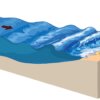Wind does not usually cause disturbance to the fill, but wind can affect other aspects of a dredging project like damaging equipment and harming personnel.
Damaging equipment
Strong winds can blow sand and dust around and if it drifts its abrasiveness can be detrimental to equipment, structures and industrial processes. Since dredging equipment is a costly investment, damage caused by “sand storms” has a financial consequence, as well as possibly slowing down the timing of work.
Harming personnel
Wind may even effect safety and health by creating visual and respiratory distress for workers and also for people downwind of the project. The negative impact of such health threats should be avoided as much as possible. Regarding workers, some measures using personal protective equipment can help defend against the effects of loose sand blowing in the wind.
Erosion
Wind erosion is a serious environmental problem and certainly during dredging operations. It is a common phenomenon occurring mostly in flat, bare areas; dry, sandy soils; or anywhere the soil is loose, dry, and finely granulated, which describes the average land reclamation.
That said, erosion of a landfill by wind is generally not significant in terms of volume loss of material. However when it does occur wind erosion is influenced by the velocity of the wind, the grain size distribution of the fill and the structure of the soil.
Soil movement as a result of wind forces can be divided into three categories:
- suspension (especially of fine grained materials);
- saltation (related to grains sizes between 0.05 and 0.5 mm); and
- surface creep (of grain sizes larger than 0.5 mm).
This movement can be controlled. How these elements are controlled is dependent on the local circumstances. Control may be possible by spraying the surface area with stabilising agents or placing a top layer of gravel on the site to withstand the wind forces causing erosion.








